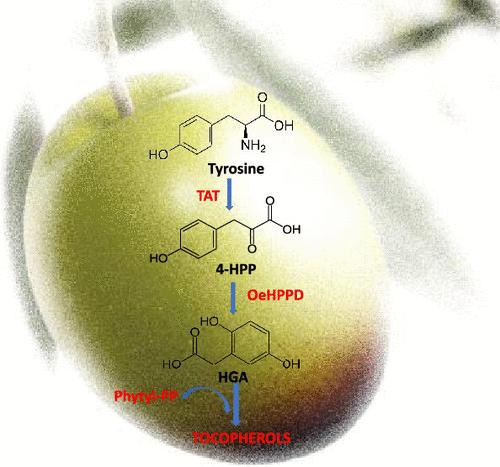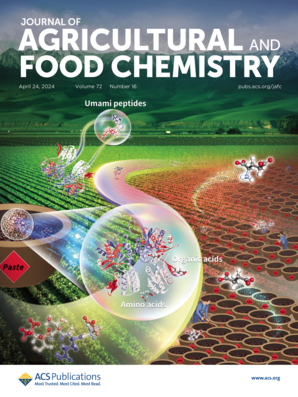参与初榨橄榄油中生育酚生物合成的橄榄4-羟基苯基丙酮酸双加氧酶的分子和生化特性
IF 6.2
1区 农林科学
Q1 AGRICULTURE, MULTIDISCIPLINARY
引用次数: 0
摘要
橄榄(Olea europaea)果实中含有大量的生育酚,这是初榨橄榄油的抗氧化和抗炎特性的主要原因。本研究重点研究了橄榄4-羟基苯基丙酮酸双加氧酶(OeHPPD)催化均质酸生物合成的分子和生化特性,均质酸是构成生育酚分子中酚残基的物质。OeHPPD是一种分子量为49.8 kDa的细胞质酶,其三级结构与拟南芥酶非常相似,表明类似的催化机制。OeHPPD的Kcat为75.26 s-1,催化效率(Km/Kcat)为0.145 μM-1 s-1,底物为4-丙酮酸羟苯酯。对不同成熟期橄榄品种果实的表达分析表明,OeHPPD基因受时间调控,具有品种依赖性。此外,对干旱胁迫下果实中OeHPPD的表达分析表明,HPPD参与了橄榄的环境适应。本文章由计算机程序翻译,如有差异,请以英文原文为准。

Molecular and Biochemical Characterization of Olive 4-Hydroxyphenyl Pyruvate Dioxygenase Involved in the Biosynthesis of Tocopherols Present in Virgin Olive Oil
Olive (Olea europaea) fruit contains high amounts of tocopherols that are responsible, along with secoiridoid phenolic compounds, for most of the antioxidant and anti-inflammatory properties of virgin olive oil. This study focuses on the molecular and biochemical characterization of olive 4-hydroxyphenyl pyruvate dioxygenase (OeHPPD) catalyzing the biosynthesis of homogentisic acid, which constitutes the phenolic residue in the tocopherol molecule. OeHPPD is a cytoplasmic enzyme with a molecular weight of 49.8 kDa and a predicted tertiary structure very similar to the Arabidopsis enzyme that suggests similar catalytic mechanisms. OeHPPD has an estimated Kcat of 75.26 s–1 and catalytic efficiency (Km/Kcat) of 0.145 μM–1 s–1 with 4-hydroxyphenyl pyruvate as the substrate. The expression analysis in fruits from selected olive cultivars harvested at different ripening stages indicates that the OeHPPD gene is temporally regulated and cultivar-dependent. Moreover, the analysis of OeHPPD expression in fruits affected by drought stress suggests that HPPD is involved in olive environmental adaptation.
求助全文
通过发布文献求助,成功后即可免费获取论文全文。
去求助
来源期刊
CiteScore
9.90
自引率
8.20%
发文量
1375
审稿时长
2.3 months
期刊介绍:
The Journal of Agricultural and Food Chemistry publishes high-quality, cutting edge original research representing complete studies and research advances dealing with the chemistry and biochemistry of agriculture and food. The Journal also encourages papers with chemistry and/or biochemistry as a major component combined with biological/sensory/nutritional/toxicological evaluation related to agriculture and/or food.

 求助内容:
求助内容: 应助结果提醒方式:
应助结果提醒方式:


